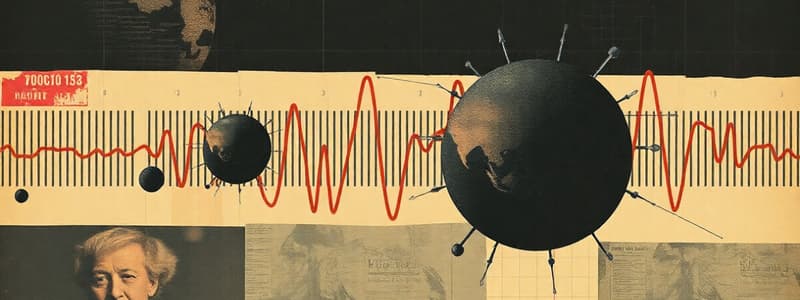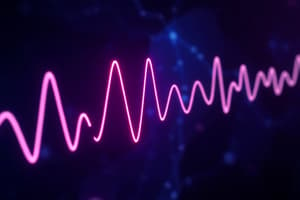Podcast
Questions and Answers
What is the potassium ion concentration outside the cell?
What is the potassium ion concentration outside the cell?
What is the ratio of potassium ions inside to outside the cell?
What is the ratio of potassium ions inside to outside the cell?
What is the Nernst potential corresponding to the potassium ion concentration ratio of 35:1?
What is the Nernst potential corresponding to the potassium ion concentration ratio of 35:1?
How does the permeability of the membrane to potassium compare to sodium?
How does the permeability of the membrane to potassium compare to sodium?
Signup and view all the answers
What primarily contributes to the normal resting membrane potential?
What primarily contributes to the normal resting membrane potential?
Signup and view all the answers
Which channel allows for the leakage of potassium ions in the resting cell membrane?
Which channel allows for the leakage of potassium ions in the resting cell membrane?
Signup and view all the answers
What is the implication of a resting membrane potential of -94 millivolts?
What is the implication of a resting membrane potential of -94 millivolts?
Signup and view all the answers
What does a sodium ion concentration ratio of inside to outside equal to 0.1 indicate?
What does a sodium ion concentration ratio of inside to outside equal to 0.1 indicate?
Signup and view all the answers
What is the Nernst potential for potassium diffusion as indicated in the content?
What is the Nernst potential for potassium diffusion as indicated in the content?
Signup and view all the answers
What equation is suggested to determine the summated potential?
What equation is suggested to determine the summated potential?
Signup and view all the answers
Which value represents a typical resting membrane potential in neurons based on the context?
Which value represents a typical resting membrane potential in neurons based on the context?
Signup and view all the answers
How is the potential described in the context specifically denoted?
How is the potential described in the context specifically denoted?
Signup and view all the answers
Which of the following is unlikely to interact with the Nernst potential for potassium?
Which of the following is unlikely to interact with the Nernst potential for potassium?
Signup and view all the answers
What is the significance of the value -94 millivolts in the context?
What is the significance of the value -94 millivolts in the context?
Signup and view all the answers
Which statement best describes the function of the Goldman equation?
Which statement best describes the function of the Goldman equation?
Signup and view all the answers
Given the Nernst potential, what does a value of -94 millivolts suggest about the state of the neuron?
Given the Nernst potential, what does a value of -94 millivolts suggest about the state of the neuron?
Signup and view all the answers
What occurs immediately after the activation of sodium channels during an action potential?
What occurs immediately after the activation of sodium channels during an action potential?
Signup and view all the answers
What is the approximate increase in sodium conductance during the action potential?
What is the approximate increase in sodium conductance during the action potential?
Signup and view all the answers
Which of the following ions is NOT primarily involved in generating the action potential as described?
Which of the following ions is NOT primarily involved in generating the action potential as described?
Signup and view all the answers
What type of ions are found inside the nerve axon that cannot pass through the membrane channels?
What type of ions are found inside the nerve axon that cannot pass through the membrane channels?
Signup and view all the answers
During the action potential, what role do negative anions play inside the axon?
During the action potential, what role do negative anions play inside the axon?
Signup and view all the answers
Which of the following correctly describes the state of sodium channels during the peak of an action potential?
Which of the following correctly describes the state of sodium channels during the peak of an action potential?
Signup and view all the answers
What happens to the membrane potential after the action potential peaks?
What happens to the membrane potential after the action potential peaks?
Signup and view all the answers
How do organic phosphate compounds within the axon influence the action potential?
How do organic phosphate compounds within the axon influence the action potential?
Signup and view all the answers
What is the all-or-nothing principle in relation to action potentials?
What is the all-or-nothing principle in relation to action potentials?
Signup and view all the answers
What role does the Na+-K+ pump play in the action potential process?
What role does the Na+-K+ pump play in the action potential process?
Signup and view all the answers
What requirement must be met for sustained propagation of an impulse in nerve fibers?
What requirement must be met for sustained propagation of an impulse in nerve fibers?
Signup and view all the answers
What happens to the production of heat during the recharging process of a nerve fiber?
What happens to the production of heat during the recharging process of a nerve fiber?
Signup and view all the answers
How does the Na+-K+ pump respond to excess sodium accumulation inside the cell?
How does the Na+-K+ pump respond to excess sodium accumulation inside the cell?
Signup and view all the answers
What is indicated by the term 'safety factor for propagation'?
What is indicated by the term 'safety factor for propagation'?
Signup and view all the answers
What occurs to the spread of depolarization when the action potential does not generate sufficient voltage?
What occurs to the spread of depolarization when the action potential does not generate sufficient voltage?
Signup and view all the answers
What characterizes the depolarization process of a normal fiber membrane during an action potential?
What characterizes the depolarization process of a normal fiber membrane during an action potential?
Signup and view all the answers
What happens to the activity of the sodium-potassium pump as intracellular sodium concentration increases from 10 to 20 mEq/L?
What happens to the activity of the sodium-potassium pump as intracellular sodium concentration increases from 10 to 20 mEq/L?
Signup and view all the answers
What is the primary effect of action potentials on sodium and potassium ion concentration differences across the membrane?
What is the primary effect of action potentials on sodium and potassium ion concentration differences across the membrane?
Signup and view all the answers
During depolarization of a nerve fiber, which ion primarily diffuses to the inside of the membrane?
During depolarization of a nerve fiber, which ion primarily diffuses to the inside of the membrane?
Signup and view all the answers
What characterizes the plateau phase in some action potentials?
What characterizes the plateau phase in some action potentials?
Signup and view all the answers
How do changes in sodium concentrations affect the recharging process of the nerve fiber?
How do changes in sodium concentrations affect the recharging process of the nerve fiber?
Signup and view all the answers
Which ions primarily diffuse out of the cell during the repolarization phase of an action potential?
Which ions primarily diffuse out of the cell during the repolarization phase of an action potential?
Signup and view all the answers
What is the consequence of a neuron experiencing repeated action potentials in terms of sodium and potassium concentrations?
What is the consequence of a neuron experiencing repeated action potentials in terms of sodium and potassium concentrations?
Signup and view all the answers
What is the relationship between sodium concentration increase and pump activity regarding the sodium-potassium pump?
What is the relationship between sodium concentration increase and pump activity regarding the sodium-potassium pump?
Signup and view all the answers
Study Notes
Ion Concentrations and Resting Membrane Potential
- Potassium (K+) concentration inside cells: 140 mEq/L; outside: 4 mEq/L.
- Sodium (Na+) concentration inside cells relative to outside: 0.1; critical for membrane dynamics.
- K+ concentration ratio (inside to outside): 35, resulting in a Nernst potential of -94 mV; indicates driving force for potassium to exit the cell during resting state.
Action Potential Dynamics
- Sodium channels activate rapidly at the onset of action potential, leading to increased Na+ conductance (up to 5000-fold).
- Action potential follows all-or-nothing principle: once initiated, depolarization propagates along the nerve membrane if threshold conditions are met.
Role of Anions and Calcium Ions
- Negatively charged impermanent ions (anions) and calcium ions play a role during the action potential.
- Anions include protein anions and organic phosphate molecules, which cannot cross the membrane but influence membrane potential.
Re-establishing Ionic Gradients
- After action potentials, sodium and potassium gradients need re-establishment via Na+-K+ pump, which requires ATP.
- Pump activity is substantially stimulated by elevated intracellular sodium levels, increasing by approximately eightfold as Na+ concentration rises from 10 to 20 mEq/L.
Energy Metabolism and Propagation Safety Factor
- Recharging of nerve fibers is an active process and measurable by increased heat production.
- For continued impulse propagation, action potential to threshold ratio must remain greater than 1, termed the "safety factor for propagation."
Plateau Phenomenon
- In certain cases, excited membranes exhibit a plateau phase where membrane potential remains near peak for several milliseconds before repolarizing, delaying the return to a resting state.
Studying That Suits You
Use AI to generate personalized quizzes and flashcards to suit your learning preferences.
Related Documents
Description
This quiz covers the essential concepts of ion concentrations, resting membrane potential, and action potential dynamics. Key topics include the role of sodium and potassium ions as well as the influence of anions and calcium ions during action potentials. Test your understanding of these fundamental neuroscience principles.



